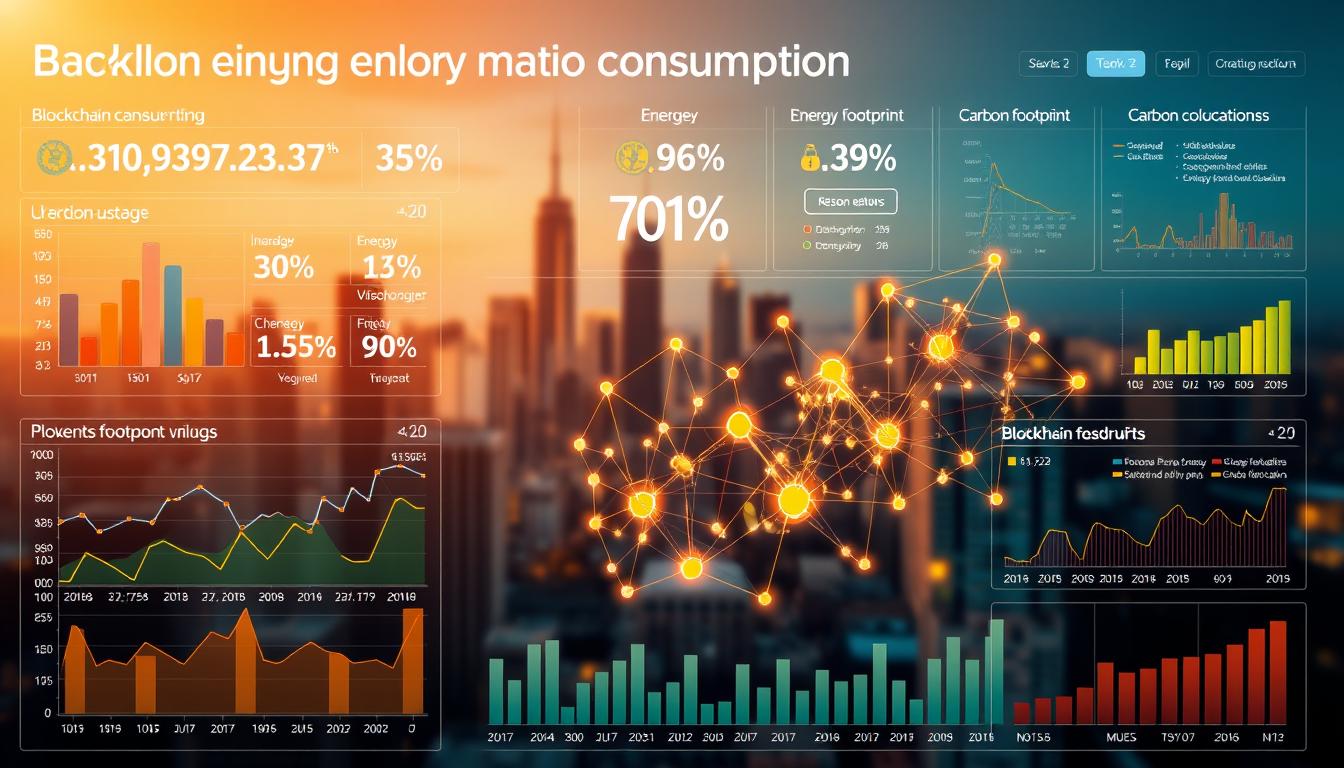Now Reading: Blockchain Energy Consumption: Facts and Figures
- 01
Blockchain Energy Consumption: Facts and Figures
Blockchain Energy Consumption: Facts and Figures
Digital currencies like Bitcoin now require as much electricity as entire nations. Recent data shows Bitcoin mining uses 155–172 terawatt-hours annually—equivalent to Poland’s total yearly power usage. This staggering demand highlights the growing debate about sustainability in tech innovation.

Market trends reveal a direct link between cryptocurrency value and resource use. As Bitcoin’s price surged past $67,000 in late 2024, mining activity intensified, pushing its market cap above $1.3 trillion. More miners mean more computers solving complex puzzles, driving up electricity needs.
The environmental impact extends beyond raw numbers. U.S.-based crypto operations produce 25–50 million tons of CO₂ yearly, rivaling mid-sized industrial sectors. While supporters argue this technology enables financial freedom, critics question whether the costs outweigh the benefits.
Key Takeaways
- Bitcoin’s annual electricity use matches Poland’s national consumption
- Crypto mining in the U.S. generates up to 50 million tons of CO₂ yearly
- Higher cryptocurrency prices directly increase mining activity
- Current systems require specialized hardware running 24/7
- Solutions must balance innovation with environmental responsibility
Industry Report: Blockchain Energy Consumption Trends
Recent industry analyses reveal startling patterns in how digital ledger systems affect power grids worldwide. The International Energy Agency reports crypto assets used 110 terawatt-hours (TWh) of electricity in 2022—enough to power 10 million US homes for a year.

Current Statistics and Projections
Bitcoin remains the dominant driver of resource use, accounting for over 65% of total crypto-related power usage. Its proof-of-work model demands constant computational power, creating an energy footprint larger than Finland’s national consumption. Experts predict a 20-35% annual increase in electricity demand if market values keep rising.
China’s 2021 mining ban reshaped global operations. Renewable sources now power just 25% of Bitcoin mining—down from 42% pre-ban—as operations shifted to regions relying on fossil fuels.
Impact on Global and US Markets
The sector’s carbon emissions now rival Ukraine’s annual output, with US-based miners contributing 25-50 million tons of CO₂ yearly. This matches the pollution from all diesel-powered trains crossing America.
Price surges directly influence mining expansion. When Bitcoin hit record highs in 2024, Texas saw a 17% spike in grid demand as miners activated new hardware. Such volatility challenges energy planners balancing industrial needs with household requirements.
Understanding the Fundamentals of blockchain energy consumption
The core mechanics of cryptocurrency validation create an unavoidable link between digital security and physical resource expenditure. Networks relying on proof-of-work consensus require vast computational power to verify transactions and maintain integrity. Over 2.9 million specialized machines operated globally in 2021 just for Bitcoin processing, illustrating the scale of these operations.

What Powers This Digital Security System?
Miners compete to solve cryptographic puzzles through brute-force calculations. Each block validation involves repeating the same mathematical operation about 15,000 times. This trial-and-error approach demands constant processing—machines make billions of guesses per second worldwide.
The system automatically adjusts puzzle difficulty every 10 minutes. This ensures consistent block creation times regardless of total computing power deployed. As more miners join the network, electricity demands rise proportionally to maintain security standards.
- Continuous operation: Mining rigs run 24/7 to maximize earning potential
- Hardware evolution: Newer machines solve puzzles faster but require more power
- Global competition: Participants worldwide race to validate blocks first
This design intentionally ties network protection to real-world resource investment. While effective for security, it creates inherent challenges for sustainable scaling. The next sections explore historical comparisons and emerging solutions to these fundamental requirements.
Historical Analysis and Comparative Data
The evolution of digital transaction systems reveals shocking disparities in resource efficiency. Early Bitcoin enthusiasts mined coins on home computers, but today’s operations demand warehouses packed with specialized machines. This shift turned a hobby into an industrial process requiring more electricity than some countries produce.

Quantifying Transaction Costs
A single Bitcoin transfer uses 1,221 kWh—enough to power a U.S. home for 42 days. That same power could handle 821,968 credit card payments through conventional networks. The math exposes a critical flaw: proof-of-work systems prioritize security over scalability.
Environmental costs amplify the issue. Each digital coin transaction generates 681 kg of CO₂—equal to 1.5 million Visa purchases. Unlike traditional finance, crypto’s limited throughput (7 transactions/second) spreads its energy footprint across fewer actions.
Even gold mining appears eco-friendly by comparison. Producing one Bitcoin’s market value in gold creates 47 tonnes of CO₂—12 times less than digital mining. These comparisons challenge claims positioning cryptocurrency as sustainable “digital gold.”
Technological Solutions and Consensus Mechanisms
The tech world is racing to address resource challenges in digital transaction systems through groundbreaking protocol changes. New validation methods slash power demands while maintaining network security, offering hope for sustainable growth.
Transitioning from Proof-of-Work to Proof-of-Stake
Ethereum’s 2022 upgrade proved consensus mechanisms can evolve dramatically. By replacing competitive mining with coin-based validation, the network cut its energy use from 79 terawatt-hours to 0.01 TWh annually. Validators now stake cryptocurrency instead of running power-hungry machines.
This shift removes the need for specialized hardware. A single transaction now uses less electricity than streaming 10 minutes of video. If Bitcoin adopted similar proof-of-stake principles, its global impact could drop to 0.15% of current levels.
Innovative Approaches in Network Efficiency
Developers are testing layered solutions to reduce computational strain. Sharding splits networks into parallel chains, while rollups bundle transactions off-chain. These methods maintain security without constant work verification.
Emerging systems like proof-of-history timestamps transactions efficiently. Hybrid models combine multiple consensus mechanisms, optimizing for speed and sustainability. Such innovations could redefine how digital systems balance performance with environmental responsibility.
Environmental Impact and Renewable Energy Integration
Digital asset networks leave lasting marks beyond electricity bills. New research reveals hidden ecological costs tied to water usage, land occupation, and lifecycle emissions. These factors complicate efforts to align crypto operations with global climate goals.
Assessing Carbon and Water Footprints
Bitcoin’s thirst for resources extends far beyond power grids. Cooling systems for mining hardware and fossil-fueled electricity generation drain 1.5–1,650 billion liters of water yearly. That’s enough to fill 660,000 Olympic pools—a startling figure given worsening global droughts.
Carbon intensity jumped 16% after China’s mining ban shifted operations to coal-dependent regions. Each transaction now carries emissions comparable to burning 75 gallons of gasoline. Full lifecycle assessments reveal deeper impacts—manufacturing specialized hardware generates 30% of total emissions.
Renewable sources face integration hurdles. Solar and wind’s intermittent nature forces miners to use backup fossil plants 40-60% of the time. Only 26% of operations use traditional clean power, though renewable energy initiatives show promise in Texas and Scandinavia.
- Land use equals 350 Central Parks (1,870 km²) for facilities
- E-waste from outdated hardware hits 35,000 tons annually
- Nuclear power boosts clean energy share to 37.6%
These findings highlight the urgent need for standardized reporting. Without accurate metrics, sustainable solutions remain guesswork in a sector racing against climate deadlines.
Regulatory and Market Challenges in Energy Use
Profit margins in crypto mining swing with market tides, pushing operators toward cost-cutting measures that ignore ecological impacts. When Bitcoin values surge, miners often prioritize renewable sources—but this commitment falters during price drops. A recent analysis shows electricity expenses consume 60-70% of mining income, forcing operations toward regions with cheaper power regardless of environmental consequences.
Balancing Costs and Sustainability
Texas’ grid operators discovered this volatility firsthand. Their demand-response program struggled when miners abandoned grid-support duties during Bitcoin’s 2024 price peak. Many facilities lease computing capacity from third-party data centers, complicating oversight of electricity sources and usage patterns.
Regulators face mounting challenges tracking dispersed mining operations that scale rapidly with price shifts. Without binding agreements for clean energy use, market swings continue dictating ecological outcomes in this high-stakes industry.
FAQ
How does Bitcoin’s electricity use compare to traditional banking systems?
Bitcoin mining uses over 100 terawatt-hours (TWh) annually, rivaling mid-sized countries like Argentina. Traditional banking, including data centers and ATMs, consumes roughly 140 TWh per year. However, crypto’s decentralized nature spreads demand globally, while banks often centralize operations in urban hubs.
What are Proof-of-Stake networks, and how do they reduce power needs?
Proof-of-Stake (PoS) systems, like Ethereum’s post-Merge upgrade, replace energy-intensive mining with validators who “stake” coins to secure transactions. This cuts electricity use by ~99.95%. Unlike Proof-of-Work (PoW), PoS eliminates competitive computing, slashing carbon footprints and operational costs.
Can renewable sources sustainably power cryptocurrency mining?
Yes. Companies like Marathon Digital use solar and wind in Texas, while Iceland’s geothermal energy supports green mining. Research by Cambridge Centre for Alternative Finance shows 39% of Bitcoin’s power mix comes from renewables. Innovations in stranded gas and hydro cooling further boost sustainability.
How do carbon footprints from mining operations impact climate goals?
PoW-based networks emit ~73 million tons of CO₂ yearly—equivalent to Oman’s total output. This challenges Paris Agreement targets. However, stricter regulations and partnerships, like Ripple’s 0M carbon credit initiative, aim to offset emissions through reforestation and tech upgrades.
What challenges do miners face with electricity price volatility?
Sudden price hikes, like Europe’s 2022 spike, force miners to relocate or pause operations. Texas offers flexible rates tied to grid demand, but global policy shifts—such as Kazakhstan’s mining ban—add uncertainty. Long-term power purchase agreements (PPAs) help stabilize costs.
What innovations are improving network efficiency in crypto?
Layer-2 solutions (e.g., Lightning Network) reduce transaction load on main chains. Advanced ASIC miners boost hash rates while cutting wattage. Immersion cooling in facilities like Bitfury’s Georgia plant lowers cooling needs by 50%, reusing heat for nearby industries.













